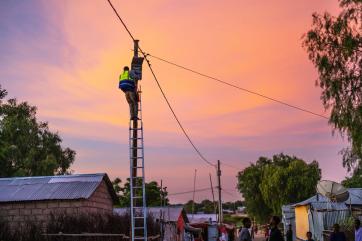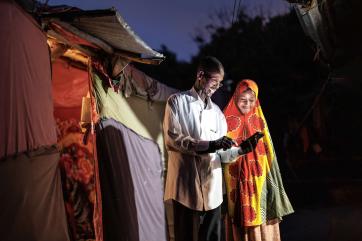Breadcrumb
Transforming Humanitarian Energy Access

The need for change
At the end of 2023, over 117 million people were displaced worldwide, with UNHCR projecting that there will be 139 million forcibly displaced persons in 2025, more than double the number from 2016. The global humanitarian system – initially designed to provide urgent, life-saving assistance in the short-term – has struggled to find solutions for protracted crises which can last for decades. Humanitarian agencies are bound to short funding cycles of one to two years which do not allow for larger and long-term investments that are crucial for the provision of improved and sustainable social services. This includes access to clean energy, a key catalyst for achieving many development goals. In refugee camps, 89% of the population lack access to electricity and 77% do not have access to clean cooking solutions, often relying on inefficient, hazardous fuel such as biomass and kerosene. Limited access to clean energy sources hampers economic development and livelihood opportunities, food and water security, increases environmental degradation, and strains peaceful coexistence of refugees and host communities.
Refugees and other displacement-affected communities are often unable to access high quality, reliable clean energy products and services for a variety of reasons. There tends to be a limited supply of these products in humanitarian settings because companies are often reluctant to work in refugee camps due to the low purchasing power of prospective customers, regulatory constraints, a lack of market information, and poor infrastructure. Even when these products are available in these settings, they are frequently perceived as being unaffordable, and a lack of familiarity with them further discourages uptake and use. Humanitarian organizations sometimes provide energy products for free, but they are often of low quality and tend to break quickly in the absence of adequate repair and maintenance services. There are also limited efforts to invest in the agency and power of displacement-affected communities and refugee-led organizations (RLOs) and enterprises as actors of change. This calls for a paradigm shift, aimed at combining the forces of the private and public sector to fund, deliver and leverage inclusive, sustainable, affordable and long-term energy interventions for communities affected by displacement.


Transforming energy delivery models for humanitarian settings
Increasingly, the way that energy is being delivered in displacement settings is beginning to change. Private companies are working together with local and international organizations to provide higher quality, sustainable lighting products and clean cooking solutions in refugee and IDP camps and settlements across East Africa. In Sheder refugee camp in Ethiopia, Mercy Corps worked together with Humanitarian Energy PLC, a local Ethiopian company, to install a solar mini-grid which serves refugee households and businesses. Another solar mini-grid has been installed by Renewvia with support from GIZ in the Kakuma refugee camp in Kenya which is currently being expanded.
The Transforming Humanitarian Energy Access (THEA) program aims to support this shift towards more sustainable energy delivery models in humanitarian settings and to increase access to clean energy solutions for displacement-affected communities. It does so by leveraging a blend of research and evidence-building, data-driven advocacy, and the implementation of market-based energy interventions. By identifying promising, inclusive energy delivery models, THEA aims to facilitate their replication and scaling, ultimately enhancing energy access for displacement-affected communities. The program will focus on three different country contexts – Uganda, Ethiopia, and Bangladesh – to identify inclusive, replicable and scalable business models along a spectrum of market readiness. THEA is implemented by Mercy Corps in partnership with Ashden and the Global Platform for Action on Sustainable Energy in Displacement Settings (GPA), and is funded by the U.K.’s Foreign, Commonwealth and Development Office (FCDO) and managed by the Carbon Trust. The program duration is from September 2024 until December 2026.
THEA’s work packages:
THEA will be delivered through three work packages (WP).
- WP1: Data-driven evidence and research at a local and global level.
- Outcome: Humanitarian stakeholders (FDPs, U.N., NGOs, donors, investors, governments, private sector) can make informed programming and policy decisions over humanitarian energy needs, gaps, and available delivery models.
- THEA will support the collection and analysis of data on humanitarian energy access to continue to fill knowledge gaps and monitor progress on increasing sustainable energy in displacement settings.
- THEA will build the evidence base on what works when it comes to delivering energy in humanitarian settings and use this knowledge to inform advocacy efforts and guide the implementation of energy interventions.
- WP2: Implementation and codification.
- Outcome: Humanitarian stakeholders have a set of inclusive and financially sustainable models that can be replicated and scaled.
- THEA will codify existing market-based energy interventions to extrapolate guidelines for other actors to inform future programming, as well scaling up and replicating existing work.
- THEA will work with refugee-led enterprises to promote new technologies and inclusive financing mechanisms to grow their businesses and capture lessons learned.
- WP3: High-level advocacy, dissemination and systemic disruption.
- Outcome: A THEA “Evidence to Action” group, composed of people with lived experience of displacement; non-energy experts and decision-makers from IOM, UNHCR, WFP and MC; and GPA Coordination Unit, meets every 6 months and coordinates on models for inclusive humanitarian energy delivery in situations of displacement.
- THEA will support the creation of an Advisory Board called the “THEA: Evidence to Action” group that will enable a bi-directional flow of information from humanitarian energy practitioners to a broader audience within humanitarian agencies and the donor community at large.
- THEA will advocate for a shift in the way humanitarian agencies deliver energy and identify potential entry points to co-design alternative delivery models that could be employed by large humanitarian agencies in alignment with their procurement processes and mandates.

Resources
Reports
- A Roadmap for Energy Access in Displacement Settings: Ethiopia
- A Roadmap for Energy Access in Displacement Settings: Uganda
Blog posts
- Driving Sustainable Energy Solutions in the Humanitarian Sector: Insights from Humanitarian Energy Ecosystem Building in Uganda | Global Platform for Action
- Financing Refugee Energy Access - Ashden
- 2024 Ashden Award winner: Patapia
- 2023 Ashden Award winner: USAFI Green Energy
- 2022 Ashden Award winner: Kakuma Ventures
- 2021 Ashden Award winner: Solar Freeze
- 2020 Ashden Award winner: United Nations Development Program Yemen
This project was funded with U.K. aid from the U.K. government via the Transforming Energy Access platform.
This material has been funded by U.K. aid from the U.K. government; however the views expressed do not necessarily reflect the U.K. government’s official policies.


